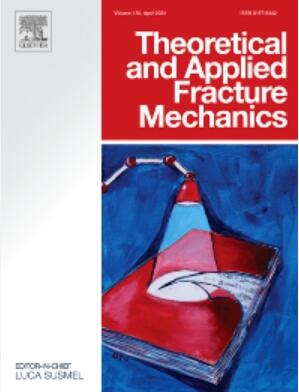A finite similitude approach to fatigue crack growth across the scales
IF 5
2区 工程技术
Q1 ENGINEERING, MECHANICAL
引用次数: 0
Abstract
Testing materials housing defects such as cracks presents difficulties for traditional experimental methods due to the presence of size effects, where the response of specimens can differ at different sizes. This issue has been addressed recently with the arrival of the finite similitude scaling theory, which is a theory for relating information across the scales, accounting for any scale effect that might be present. The theory introduces an infinite number of possible similitude rules with lower-order rules (e.g., zeroth, first, and second) having the most practical value, with zeroth order being equivalent to dimensional analysis, and first order able to accommodate the theories of fracture mechanics and fatigue. The first-order finite-similitude rule can be applied experimentally by performing tests at two distinct scales but also analytically at an arbitrary scale but involving additional equations. To confirm that the approach has practical value it is tested in this work against experimental-fatigue data that has appeared recently in the open literature. Numerical simulation is performed with a commercially available finite-element package in support of the study to assess the robustness of the scaled-experimental tests and compliance with the finite-similitude theory. The response of the empirical Paris crack-growth law under scaling is examined to test the criticality of using either scale-invariant or scale-variant parameters in crack-growth predictions. Introduced as part of the work is a method for the experimental determination of Paris-law parameters under the sound assumption that the correct similarity law for fracture-fatigue studies is the first-order finite-similitude rule. The results presented here confirm the veracity and applicability of the finite-similitude scaling theory returning analytical and numerical confirmations to within a few percent of published experimental results.
求助全文
约1分钟内获得全文
求助全文
来源期刊

Theoretical and Applied Fracture Mechanics
工程技术-工程:机械
CiteScore
8.40
自引率
18.90%
发文量
435
审稿时长
37 days
期刊介绍:
Theoretical and Applied Fracture Mechanics'' aims & scopes have been re-designed to cover both the theoretical, applied, and numerical aspects associated with those cracking related phenomena taking place, at a micro-, meso-, and macroscopic level, in materials/components/structures of any kind.
The journal aims to cover the cracking/mechanical behaviour of materials/components/structures in those situations involving both time-independent and time-dependent system of external forces/moments (such as, for instance, quasi-static, impulsive, impact, blasting, creep, contact, and fatigue loading). Since, under the above circumstances, the mechanical behaviour of cracked materials/components/structures is also affected by the environmental conditions, the journal would consider also those theoretical/experimental research works investigating the effect of external variables such as, for instance, the effect of corrosive environments as well as of high/low-temperature.
 求助内容:
求助内容: 应助结果提醒方式:
应助结果提醒方式:


